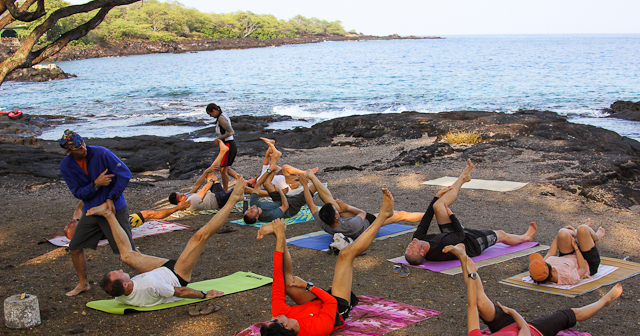Warmup, Workout, Stretch, Recover
by Cat Fitzgerald - March 29th
No specific movement this month; instead I want you to simply be present in your training and try this methodology: Warm up, Workout, Stretch, and Recover.


There has been a lot of controversy lately about whether or not to stretch and if flexibility is necessary or a better condition than “inflexible” (see articles in Men’s Health, New York Times, Miami Herald, Shape, etc). Critical thinking skills seem to be drowning like Dolphins in the vast fear-mongering drift nets of media and politics. I have read many of these articles and, while the cover may spell dismay over your time spent stretching, the conclusions that they draw are that stretching is fine, if not great, it is when and how you stretch that matters. Flexibility in body is akin to that of mind. If you are too flexible it is difficult to come to a decision or answer a call to action, it creates a sloppy feel. I don’t generally refer to that as flexible (see last April’s article). Skipping ahead: I find it best to do a warm up, then workout, and stretch at the end (unless I am doing a resistance stretch as my workout). Each section has its’ own goal; don’t conflate them. Warm up: Goal, to get the blood flowing, boost the heart rate a bit, and take an inventory of the body to check for injuries, aches, elasticity, etc; How, start with slow motions that grow in range of motion, and possibly speed, from hips out (Hula dance, to torso circles, arm circles, elbow, wrist, neck [keep extension], legs circles, knees [mogul skiing] to ankles and toes). This is also to build a constant dialogue and feedback system for you to use during your workout and then for your stretch. Workout: test previous experience, maintain or increase an aspect of our activity/sport/strength/happiness etc. Stretching: (what I find to be of most use for the professional athlete to daily grinder) to relieve tension and blocks to mobility; to increase functional use of muscle (maximize muscles ability to contract and elongate) in concentric (contracting and shortening a muscle – like walking upstairs), eccentric (contracting and elongating a muscle – like walking downstairs), and isometric (a static contraction of muscle – like sitting against a wall as if you were in a chair, but without one) capacities; improve my athletic endeavor through speed, power , fluidity, dynamics, ease and speed of recovery and other qualifications in and quantifications. I personally use resistance stretching , plyometrics, and bodyweight exercises in my own blend as my workout (tweaked for the individual sport). Keeping the goal of stretching as trying to maximize the three methods of muscle movement (isometric, concentric, and eccentric) then we are creating an essential element to our training.
Cat
